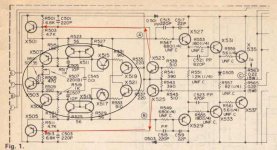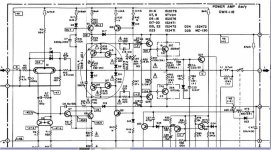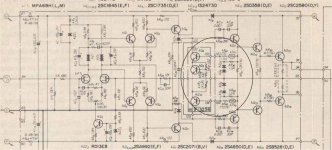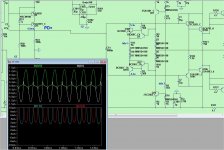Ok, i found him sometimes brutal, and tried to express several time this feeling in PM to him.I find it annoying and really rude when someone pops into the thread and tells OS he should stop doing what he obviously enjoys because the their design can't be improved on.
This said, English is not his native language (like me, i was just accused to be a troll in an other thread ;-), and he explained he had not many time left, between his real job (not in electronic) and his hifi hobby. This can explain his lack of nuances ?
I don't think he wanted to stop OS, not at all. Just trying to keep its attention to the interest to listen in order to can make good choices that no simulation can discriminate.
On my side, as a designer myself, i'm passionate by the OS's work. Encyclopedic. It gave-me a lot of ideas. But, as L.C., i asked myself questions about how to figure out the pro and cons of each details when there is so much differences between two IPS, as an example. I use to try things one by one and feel their "character".
On the other side, i was impressed by the beauty and apparent simplicity of the LC designs, at first sight on his schematics, and by the degree of optimization when i dig more inside. And found him not always open minded to other's suggestions or different approach. But i'm sure, for what i know of peoples at the end of my life, meeting such a high level of passion and artistic sensibility, that he cannot be as you suppose, commercial. See what i mean ?
This said with all my heart, hoping that they can learn from each other as much as i had from both of them.
Last edited:
I understand the language barrier. Most of the North American members here will likely realise my crack about posting in Lazy Cat's thread was a joke. His VSSA amp is definitely a fine little amplifier in the lower power range. I think personally I'd be happier with a higher powered unit. That's what I'm accustomed to and seems to work well with my speakers. As Lazy Cat keeps repeating, the proof is in listening. That's what I am trying to accomplish. My electronics background has been limited to mainly automotive applications and is self taught so this analogue audio endeavour is a whole new world to me but at the same time I am able to look at it from a totally different perspective. The acronyms are brutal to figure out though.
My own speculation, please take as is. Seen by diy eyes maybe not beautiful LC did go commercial sector at a time and holding some tricks/circuits/layout for himself, but take a look at the process when member "5th element" did a slewmaster version, that how much influence component material/brand + layout and even wire layout can mean for a build to be at highest performance. By going commercial LC ensure some chance that we get same performance and sound as he do and free himself from +50 questions a day about problems getting the circuit performing as he claim and free of errors. For VSSA modules buyers needed to do some component soldering and choosing their capacitor brand + final they should calibrate the amp which did some differences between builds, for FO all come assembled and calibrated which ensure more all get the claimed performance, at same cost for modules seems fair and not a cash machine.
I think all the different offers is lovely choice to have, lower bandwidth/speed 20Khz squarewaves go PeeCeeBee variances, higher bandwidth/speed >100Khz squarerwaves go a slewmaster version, VSSA or FO.
I think all the different offers is lovely choice to have, lower bandwidth/speed 20Khz squarewaves go PeeCeeBee variances, higher bandwidth/speed >100Khz squarerwaves go a slewmaster version, VSSA or FO.
Going commercial only guarantees the quality of the amplifier module itself. It's still up to the installer to build/ select and implement a power supply and proper protection, house it in a chassis and correctly connect it. All of which are as important or more so than the selection of components in the amp. From the bit of fumbling I've done with OS's designs, component selection really doesn't seem that critical. They work well with just about anything. I've used four different sets of output devices. Capacitors are whatever I have or can get easily. Carbon film and metal resistors. No noticeable difference. The crowd that can hear the difference between yellow and blue insulation on the wire might not agree but I'm not really that concerned.
I deeply appreciate any and all comments by keentoken , dadod , and Lazy cat.
Without Pinocchio's "conscience" , he would make more lies ! 😀
But , life in the virtual world can only go so far. If I actually HAD one of my amps, who knows what wondrous improvements I might come up with ?
I am working on the kypton V , I WILL let the toner people have it even as
it is sort of a "first one" (really good - sonic wise and technically).
One might hear an improvement on the "V". Driving a headphone amp or
a non-switching OPS.
That is why I am "giving" the V (toner)away. I've already posted the V/C ...
they are now public domain , maybe some chinese pirates will jump on it 😀.
As far as the non-switching/error correcting output stage .... it is much
harder - If (when) I really get it perfected , it would be a shame to get
nothing but praise for it.
Praise is nice !! 🙂🙂 But , it gets me no closer to my own amp.
OS
Without Pinocchio's "conscience" , he would make more lies ! 😀
But , life in the virtual world can only go so far. If I actually HAD one of my amps, who knows what wondrous improvements I might come up with ?
I am working on the kypton V , I WILL let the toner people have it even as
it is sort of a "first one" (really good - sonic wise and technically).
One might hear an improvement on the "V". Driving a headphone amp or
a non-switching OPS.
It is at this moment that the moderation of this forum decided to move his thread to the commercial area.
That is why I am "giving" the V (toner)away. I've already posted the V/C ...
they are now public domain , maybe some chinese pirates will jump on it 😀.
As far as the non-switching/error correcting output stage .... it is much
harder - If (when) I really get it perfected , it would be a shame to get
nothing but praise for it.
Praise is nice !! 🙂🙂 But , it gets me no closer to my own amp.
OS
If you don't have them yet, you should be receiving some PCBs very soon.
Thank you ,JK !! VERY professional renditions. EXCELLENT work ! 🙂
(I have them).
OS
The next level ....
I have browsed the forum , the AES papers , and the whole of the WWW.
It has been discussed to death (blah blah blah) , but no one has made a
"pitchfork villager" version of the non-switching/EC output stage (as a kit/
or layout).
- It must be (sort of) simple .... no matching , special components.
- It's local feedback loop(s) must not conflict with any IPS's ... and it
should not "slow down" any fast IPS - slew baby !! 😀
-In isolation - it should beat the slewmaster EF3's .05% THD.
I have found the original JVC "super A" (before it became a chip - below 1).
It is dynamically controlling the bias spreader (X503-below 1) and has error
correction (red arrows to X501/505).
Another one is the pioneer (below 2). It uses symmetric super-pairs(circled) for feedback to the simple bias spreader (VR5/D7). It uses a standard EF3
plus current sources. It is more simple (with no final output error
correction) , but has a cool 😎 non- switching and traditional bias adjustment(vr7/vr5).
And - the sansui (below 3), is just a curiosity (too simple 🙄) - I do like it's IPS .... I might try it on the kypton V !!!
To TEST the merits of any of these "abominations" 😀 , their effect on the
amp as whole must be minimal (besides any improvement).
I'll start with the Pioneer - it seems to need the least local nested compensation and uses basically the standard slewmaster EF3 for OPS.
Tonight , the best of these will be discussed.
PS - it WILL be ported to FET's , as well.
Also , none of the existing IPS's will be "Vaporware" .... they are all sub PPM
(or close) with a class A OPS
... I want this performance at 100W (A better OPS is the ONLY way).
OS
I have browsed the forum , the AES papers , and the whole of the WWW.
It has been discussed to death (blah blah blah) , but no one has made a
"pitchfork villager" version of the non-switching/EC output stage (as a kit/
or layout).
- It must be (sort of) simple .... no matching , special components.
- It's local feedback loop(s) must not conflict with any IPS's ... and it
should not "slow down" any fast IPS - slew baby !! 😀
-In isolation - it should beat the slewmaster EF3's .05% THD.
I have found the original JVC "super A" (before it became a chip - below 1).
It is dynamically controlling the bias spreader (X503-below 1) and has error
correction (red arrows to X501/505).
Another one is the pioneer (below 2). It uses symmetric super-pairs(circled) for feedback to the simple bias spreader (VR5/D7). It uses a standard EF3
plus current sources. It is more simple (with no final output error
correction) , but has a cool 😎 non- switching and traditional bias adjustment(vr7/vr5).
And - the sansui (below 3), is just a curiosity (too simple 🙄) - I do like it's IPS .... I might try it on the kypton V !!!
To TEST the merits of any of these "abominations" 😀 , their effect on the
amp as whole must be minimal (besides any improvement).
I'll start with the Pioneer - it seems to need the least local nested compensation and uses basically the standard slewmaster EF3 for OPS.
Tonight , the best of these will be discussed.
PS - it WILL be ported to FET's , as well.
Also , none of the existing IPS's will be "Vaporware" .... they are all sub PPM
(or close) with a class A OPS
... I want this performance at 100W (A better OPS is the ONLY way).
OS
Attachments
DIY SPIRIT
All ostripper designed INPUTS and OUTPUTS are functional even with common, non exotic parts .
Os gives us everything.Schematics ,pcb,gerbers,HELP,everything.
That is the spirit of DIY.
Thanks OS .
All ostripper designed INPUTS and OUTPUTS are functional even with common, non exotic parts .
Os gives us everything.Schematics ,pcb,gerbers,HELP,everything.
That is the spirit of DIY.
Thanks OS .
OS why don't you make a prioritized list of your needs and post them, I think a lot of us have lot of parts in multiples that could stand a reduction in count just for you.😱
Sort of like a reverse BOM just for an OS DIY payment in kind.🙄
Name it and claim it...😀
Thanks for ALL your hard and down in the trenches work and your untiring SHARING of all you have done.
Are you going to change your location in the Avatar. So the parts and "checks" can be sent to the right place.😉
Sort of like a reverse BOM just for an OS DIY payment in kind.🙄
Name it and claim it...😀
Thanks for ALL your hard and down in the trenches work and your untiring SHARING of all you have done.

Are you going to change your location in the Avatar. So the parts and "checks" can be sent to the right place.😉
I am very happy to receive such offers.
I'm not the type to ask for much.
My move to Tennessee involved a
certain moving company(PODS). They advertised "climate controlled" for my
electronics. HA ! Candles actually melted , 2 whole computers had bad caps
after the move .... I lost 1/2 of all my PC's. I estimate 80+ Celsius in the
"pod" destroyed hard drives + motherboards (capacitors).
I have the core duo/memory from the one destroyed "good PC" - they work,
had to buy all the other parts.
Luckily , this PC (4 core) was all solid state caps (a new asus) , only lost
my 2TB movie hard drive ... my "slewmaster" HDD survived.
I have 2 hefty toriods with 2 capacitor banks/bridges -but only 50-0-50V.
I found a new car amp with 4 pair 2sa1673/2sc4388 - tested good.
No case or heatsinks.
I'm lacking small semi's/caps/resistors.
I like JK's
slewmaster boards (and the designs) better. ALL slewmaster for my house.
I have 1 subwoofer - needs an amp.
and 2 nice pair of full range speakers - 5 pair would be too much for either
(slewmonster with just 3 pair).
PS-I even have a nearly fully stuffed pair of "badgers" I could trade.
OS
I'm not the type to ask for much.
My move to Tennessee involved a
certain moving company(PODS). They advertised "climate controlled" for my
electronics. HA ! Candles actually melted , 2 whole computers had bad caps
after the move .... I lost 1/2 of all my PC's. I estimate 80+ Celsius in the
"pod" destroyed hard drives + motherboards (capacitors).
I have the core duo/memory from the one destroyed "good PC" - they work,
had to buy all the other parts.
Luckily , this PC (4 core) was all solid state caps (a new asus) , only lost
my 2TB movie hard drive ... my "slewmaster" HDD survived.
I have 2 hefty toriods with 2 capacitor banks/bridges -but only 50-0-50V.
I found a new car amp with 4 pair 2sa1673/2sc4388 - tested good.
No case or heatsinks.
I'm lacking small semi's/caps/resistors.
I like JK's
slewmaster boards (and the designs) better. ALL slewmaster for my house.
I have 1 subwoofer - needs an amp.
and 2 nice pair of full range speakers - 5 pair would be too much for either
(slewmonster with just 3 pair).
PS-I even have a nearly fully stuffed pair of "badgers" I could trade.
OS
I have a pair of stuffed and tested 2P slewmaster OPS if you can use it. I can also send the parts for a pair of IPS just tell me which one. If your would rather have a pair already stuffed I have CFA-XH and Symasui, take your pick. You are welcome to any of this. PM me your address.
Blessings, Terry
EDIT; I can also send output transistors for a pair of 3P slewmaster. Take your pick from MJL4281/4302, NJW 0282/0302, MJW21193/94
Blessings, Terry
EDIT; I can also send output transistors for a pair of 3P slewmaster. Take your pick from MJL4281/4302, NJW 0282/0302, MJW21193/94
Last edited:
pioneer non -switching spice
The (below) circuit works as advertised. ! 🙄
"Idle 1" is the main Vbe bias , it stays at 80ma 20hz to 20k - any power level.
"Idle 2" will adjust the non-switching threshold between 2-20ma.
No oscillation ..... BUT the EF3's distortion doubled (in isolation).
THOSE DIRTY DIODES.
Plus - 2R loads (or a reactive load/speaker), allows switching to take place.
I suppose with cheap japan 8R OEM speakers... this might be minimized ??
This was the topic on the "super A thread" - diode distortion...http://www.diyaudio.com/forums/solid-state/162559-new-class-super-non-switching-need-revival.html
Carlo's amp uses the pioneer/sansui/technics "poor man's" approach.
NOT 🙄🙄 Super A -
http://www.diyaudio.com/forums/solid-state/221741-dx-blame-st-together-dx-super.html
JVC's real "super A" is much more like the yamaha hyperbolic or this-
http://home.tiscali.nl/data.odyssey/AutoBias_II.html
So , I guess nothing that is heavenly could be as easy as the pioneer ...
they are scammers- they create "non-switching" at the expense of
linearity/THD (just for marketing).
PS - ASC below.
OS
The (below) circuit works as advertised. ! 🙄
"Idle 1" is the main Vbe bias , it stays at 80ma 20hz to 20k - any power level.
"Idle 2" will adjust the non-switching threshold between 2-20ma.
No oscillation ..... BUT the EF3's distortion doubled (in isolation).
THOSE DIRTY DIODES.
Plus - 2R loads (or a reactive load/speaker), allows switching to take place.
I suppose with cheap japan 8R OEM speakers... this might be minimized ??
This was the topic on the "super A thread" - diode distortion...http://www.diyaudio.com/forums/solid-state/162559-new-class-super-non-switching-need-revival.html
Carlo's amp uses the pioneer/sansui/technics "poor man's" approach.
NOT 🙄🙄 Super A -
http://www.diyaudio.com/forums/solid-state/221741-dx-blame-st-together-dx-super.html
JVC's real "super A" is much more like the yamaha hyperbolic or this-
http://home.tiscali.nl/data.odyssey/AutoBias_II.html
So , I guess nothing that is heavenly could be as easy as the pioneer ...
they are scammers- they create "non-switching" at the expense of
linearity/THD (just for marketing).
PS - ASC below.
OS
Attachments
Hi OS, just to add to the picture 😉
There was also a Technics "New class A" approach, relying on low voltage drop, fast diodes clamp, limiting the minimal bias when upper or lower shoulder is inactive. Rather simple yet efficient (at a first glance).
Attached is a fragment of SU-V8 OPS.
Modern Schottky diodes are even faster than the ones available at that time...
Cheers,
Valery
There was also a Technics "New class A" approach, relying on low voltage drop, fast diodes clamp, limiting the minimal bias when upper or lower shoulder is inactive. Rather simple yet efficient (at a first glance).
Attached is a fragment of SU-V8 OPS.
Modern Schottky diodes are even faster than the ones available at that time...
Cheers,
Valery
Attachments
On the other hand... See >THIS<
Just tested yesterday. Practically measured. Overall amp distortion level is lower, than the one claimed by any of the recently mentioned manufacturers with their "non-switching" approaches. Even at 20KHz. And this is not the most linear one (IRFPs)...
So... the question is - is it worth worrying about? 😕
Just tested yesterday. Practically measured. Overall amp distortion level is lower, than the one claimed by any of the recently mentioned manufacturers with their "non-switching" approaches. Even at 20KHz. And this is not the most linear one (IRFPs)...
So... the question is - is it worth worrying about? 😕
I have a pair of stuffed and tested 2P slewmaster OPS if you can use it. I can also send the parts for a pair of IPS just tell me which one. If your would rather have a pair already stuffed I have CFA-XH and Symasui, take your pick. You are welcome to any of this. PM me your address.
Blessings, Terry
EDIT; I can also send output transistors for a pair of 3P slewmaster. Take your pick from MJL4281/4302, NJW 0282/0302, MJW21193/94
You are a real gentleman , Terry.
I'll PM you. Thanks.
OS
Hi OS, just to add to the picture 😉
There was also a Technics "New class A" approach, relying on low voltage drop, fast diodes clamp, limiting the minimal bias when upper or lower shoulder is inactive. Rather simple yet efficient (at a first glance).
Attached is a fragment of SU-V8 OPS.
Modern Schottky diodes are even faster than the ones available at that time...
Cheers,
Valery
That Technics also has EC (error correction). More to it than just a diode reference (+buffer/clamp). The reactive load of the speaker is measured
at the output emitter resistor(s) and fed back to the clamp.
But they still use diodes as the clamp's reference.
I will try this one next. Thanks for the schema (I can read it)
I would predict the EC would offset the added
THD from the clamp. 😕
PS -(below-.03%) ... is the base THD20K of a slewmaster EF3 OPS
(20K/4R/75ma bias) @ 60V p-p .
Edit- my observation of the pioneer - this THD20 rises to .065% , but the 3rd
harmonic decreases. More total thd in return for less odd harmonics.
OS
Attachments
So... the question is - is it worth worrying about?
Now that you mention it ? This is a valid point.
One can test a virtually distortion-less amp into a static monster resistor
and approach "Halcro heaven" 😀.
But , hook that same amp to a very reactive speaker (no heaven - sometimes
hell) .
I am into the "real" EC @ the output resistor .... as that will try to correct
the output ... even as the speaker is "fighting" NFB.
PS- A VFA's NFB can not correct this "real world" effect. Nor can a CFA's.
The odd order cancellation is why they love class A , the ineffectual compensation of NFB for a very reactive load is why "they" HATE NFB. 😀
Edit -vzaichenko , this is why I am prioritizing a new OPS - it is the "weak link" (speaker wise).
OS
Last edited:
- Home
- Amplifiers
- Solid State
- Slewmaster - CFA vs. VFA "Rumble"





